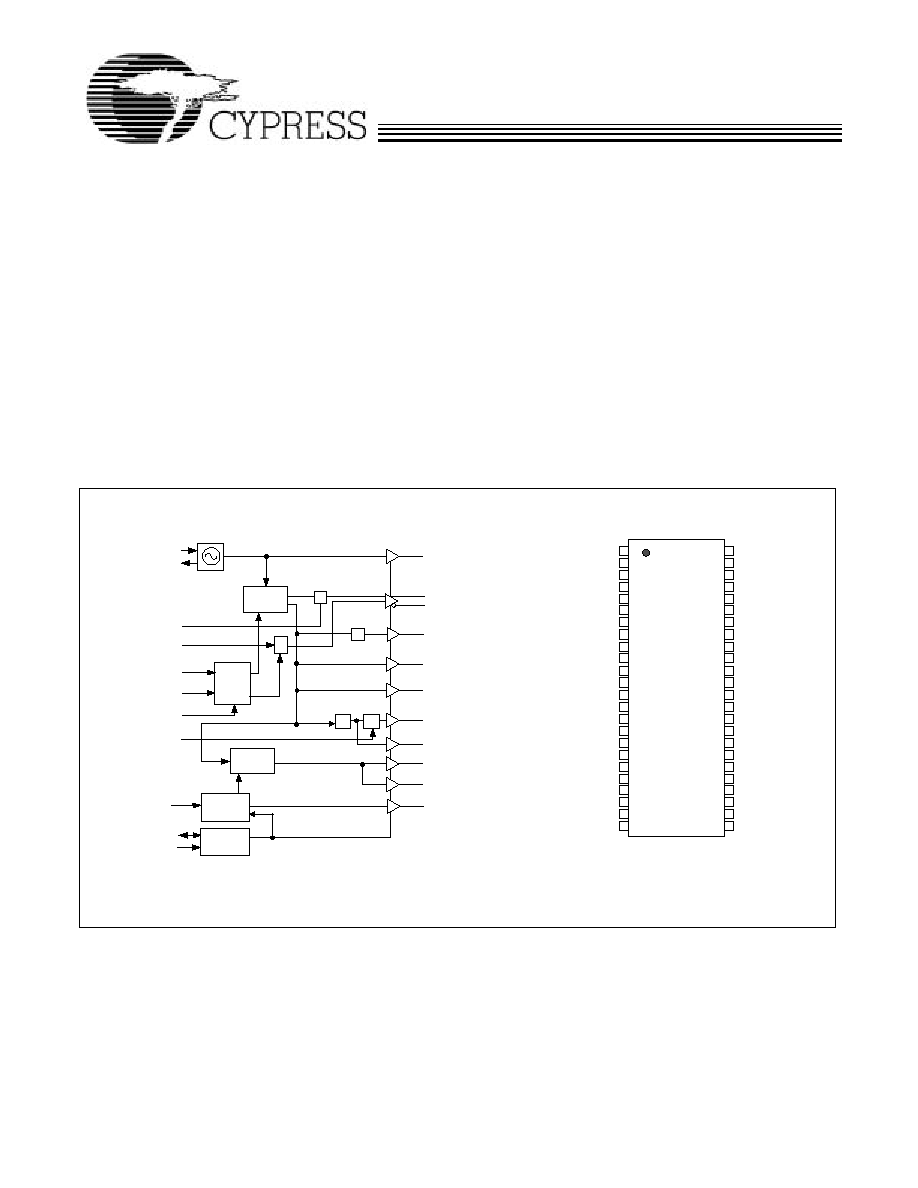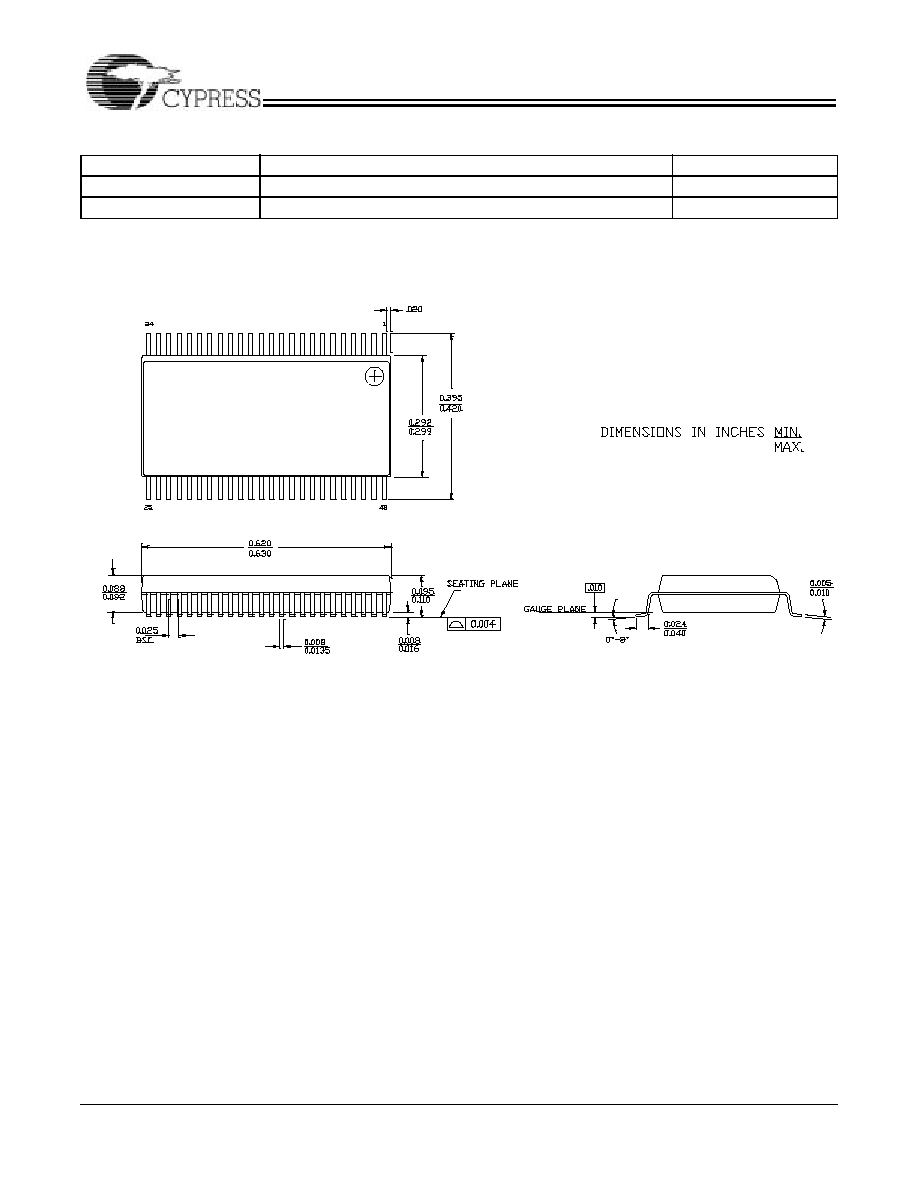 | –≠–ª–µ–∫—Ç—Ä–æ–Ω–Ω—ã–π –∫–æ–º–ø–æ–Ω–µ–Ω—Ç: CY28381 | –°–∫–∞—á–∞—Ç—å:  PDF PDF  ZIP ZIP |

High-Performance SiS645DX/648DX/650/651
Intel Pentium
4 Clock Synthesizer
CY28381
Cypress Semiconductor Corporation
∑
3901 North First Street
∑
San Jose
,
CA 95134
∑
408-943-2600
Document #: 38-07546 Rev. **
Revised May 20, 2003
Features
∑ Supports Pentium
Æ
4-type CPUs
∑ 3.3V power supply
∑ Eight copies of PCI clocks
∑ One 48-MHz USB clock
∑ Two copies of ZCLK cocks
∑ One 48-MHz/24-MHz Programmable SIO clock
∑ Two differential CPU clock pairs
∑ SMBus support with readback capabilities
∑ Spread Spectrum electromagnetic interference (EMI)
reduction
∑ Dial-A-Frequency
Æ
features
∑ Dial-A-RatioTM features
∑ Dial-A-dBTM features
∑ 48-pin SSOP Package
∑ Watchdog function
Note:
1.
Pins marked with [*] have internal 150K pull-up resistors. Pins marked with [**] have internal 150K pull-down resistors.
Block Diagram
Pin Configuration
[1]
PLL1
PLL2
/2
WD
Logic
XIN
XOUT
CPU_STP#
IREF
FS[0:4]
MULT0
VTT_PWRGD
PCI_STP#
PD#
SDATA
SCLK
48M_24M#
48M
PCIF[0:1]
PCI[0:5]
ZCLK[0:1]
AGP[0:1]
CPUC[0:1]
CPUT[0:1]
REF(0:2)
I2C
Logic
SRESET#
Power
on
Latch
SDCLK
1
2
3
4
5
6
7
8
9
10
11
12
13
14
15
16
17
18
19
20
21
22
23
24
48
47
46
45
44
43
42
41
40
39
38
37
36
35
34
33
32
31
30
29
28
27
26
25
VDDSD
SDCLK
VSSSD
CPU_STP#*
CPUT1
CPUC1
VDDC
VSSC
CPUT0
CPUC0
IREF
VSSA
VDDA
SCLK
SDATA
PD#/VTT_PWRGD*
VSSAGP
AGP0
AGP1
VDDAGP
VDD48M
48M
24_48M/MULT0*
VSS48M
VDDR
**FS0/REF0
**FS1/REF1
**FS2/REF2
VSSR
XIN
XOUT
VSSZ
ZCLK0
ZCLK1
VDDZ
*SRESET#/PCI_STP#
VDDP
**FS3/PCIF0
PCI0
**FS4/PCIF1
PCI1
VSSP
VDDP
PCI2
PCI3
PCI4
PCI5
VSSP
CY
28381
48 pin SSOP

CY28381
Document #: 38-07546 Rev. **
Page 2 of 19
Pin Description
[2]
Pin
Name
PWR
I/O
Description
6
XIN
I
Oscillator Buffer Input. Connect to a crystal or to an external clock.
7
XOUT
VDDR
O
Oscillator Buffer Output. Connect to a crystal. Do not connect when an
external clock is applied at XIN.
40,44
CPU[0:1]
VDDC
O
"True" Host Output Clocks. See Table 1 for frequencies and functionality.
39,43
CPUC[0:1]
VDDC
O
"Complementary" Host Output Clocks. See Table 1 for frequencies and
functionality.
16,17,20,23 PCI [0:5]
VDDP
O
PCI Clock Outputs. See Table 1.
14
FS3/PCIF0
VDDP
I/O
PD
Power-on Bidirectional Input/Output. At power-up, FS3 is the input. When
VTT_PWRGD transitions to a logic high, FS3 state is latched and this pin
becomes PCIF0 Clock Output. See Table 1.
15
FS4/PCIF1
VDDP
I/O
PD
Power-on Bidirectional Input/Output. At power-up, FS4 is the input. When
VTT_PWRGD transitions to a logic high, FS4 state is latched and this pin
becomes PCIF1 Clock Output. See Table 1.
2
FS0/REF0
VDDR
I/O
PD
Power-on Bidirectional Input/Output. At power-up, FS0 is the input. When
VTT_PWRGD transitions to a logic high, FS0 state is latched and this pin
becomes REF0, buffered Output copy of the device's XIN clock.
3
FS1/REF1
VDDR
I/O
PD
Power-on Bidirectional Input/Output. At power-up, FS1 is the input. When
VTT_PWRGD is transited to logic low, FS1 state is latched and this pin
becomes REF1, buffered Output copy of the device's XIN clock.
4
FS2/REF2
VDDR
I/O
PD
Power-on Bidirectional Input/Output. At power-up, FS2 is the input. When
VTT_PWRGD is transited to logic low, FS2 state is latched and this pin
becomes REF2, buffered Output copy of the device's XIN clock.
38
IREF
I
Current Reference Programming Input for CPU Buffers. A resistor is
connected between this pin and VSS. See Figure 9.
33
PD#/
VTT_PRGD
VDDAGP
I
PU
Power-down Input/VTT Power Good Input. At power-up, VTT_PWRGD is
the input. When this input is transitions initially from low to high, the FS (0:4)
and MULT0 are latched. After the first low to high transition, this pin become
a PD# input with an internal pull-up. When PD# is asserted low, the device
enters power down mode. See power management function.
27
48M
VDD48M
O
Fixed 48MHz USB Clock Output.
26
24_48M/
MULT0
VDD48M
I/O
PU
Power-on Bidirectional Input/Output. At power-up, MULT0 is the input.
When VTT_PWRGD is transited to logic low, MULT0 state is latched and this
pin becomes 24_48M, SIO programmable clock output.
9,10
ZCLK (0:1)
VDDZ
O
HyperZip Clock Outputs. See Table 1.
34
SDATA
VDDAGP
I/O
Serial Data Input. Conforms to the SMBus specification of a Slave
Receive/Transmit device. It is an input when receiving data. It is an open drain
output when acknowledging or transmitting data.
35
SCLK
VDDAGP
I
Serial Clock Input. Conforms to the SMBus specification.
12
SRESET#
VDDZ
O
PCI Clock Disable Input. If Byte12 Bit7 = 0, this pin becomes an SRESET#
open drain output, and the internal pulled up is not active. See system reset
description.
PCI_STP#
VDDZ
I
PU
System Reset Control Output. If Byte12 Bit7 = 1 (Default), this pin becomes
PCI Clock Disable Input. When PCI_STP# is asserted low, PCI (0:5) clocks
are synchronously disabled in a low state. This pin does not affect PCIF (0:1)
if they are programmed to be free-running clocks via the device's SMBus
interface.
45
CPU_STP#
VDDSD
I
PU
CPU Clock Disable Input. When asserted low, CPU (0:1)T clocks are
synchronously disabled in a high state and CPU (0:1)C clocks are synchro-
nously disabled in a low state.
47
SDCLK
VDDSD
O
SDRAM Clock Output.
30,31
AGP (0:1)
VDDAGP
O
AGP Clock Outputs. See Table 1 for frequencies and functionality.
Note:
2.
PU = internal pull-up. PD = internal pull-down. T = Tri-level logic input with valid logic voltages of LOW =<0.8V, T =1.0 -1.8V and HIGH => 2.0V.

CY28381
Document #: 38-07546 Rev. **
Page 3 of 19
48
VDDSD
PWR 3.3V Power Supply for SDRAM Clock Output.
29
VDDAGP
PWR 3.3V Power Supply for AGP Clock Outputs.
11
VDDZ
PWR 3.3V Power Supply for HyperZip Clock Outputs.
1
VDDR
PWR 3.3V Power Supply for REF Clock Outputs.
13,19
VDDP
PWR 3.3V Power Supply for PCI Clock Outputs.
42
VDDC
PWR 3.3V Power Supply for CPU Clock Outputs.
28
VDD48M
PWR 3.3V Power Supply for 48-MHz/24-MHz Clock Outputs.
36
VDDA
PWR 3.3V Analog Power Supply.
18,24
VSSP
PWR GND for PCI Clocks Outputs.
41
VSSC
PWR GND for CPU Clocks Outputs.
8
VSSZ
PWR GND for HyperZip Clock Outputs.
25
VSS48M
PWR GND for 48-MHz/24-MHz Clock Outputs.
5
VSSR
PWR GND for REF Clock Outputs.
46
VSSSD
PWR GND for SDRAM Clock Output.
32
VSSAGP
PWR GND for AGP Clock Outputs.
37
VSSA
PWR GND for Analog.
Table 1. Frequency Table
FS(4:0)
CPU(MHz)
SDRAM(MHz)
ZCLK(MHz)
AGP(MHz
PCI(MHz)
VCO(MHz)
00000
100.2
100.2
80.2
66.8
33.4
400.8
00001
100.2
133.6
80.2
66.8
33.4
400.8
00010
100.2
200.4
80.2
66.8
33.4
400.8
00011
100.2
167.0
83.5
62.6
31.3
501.0
00100
133.6
100.2
80.2
66.8
33.4
400.8
00101
133.6
133.6
80.2
66.8
33.4
400.8
00110
133.6
200.4
80.2
66.8
33.4
400.8
00111
133.6
167.0
83.5
66.8
33.4
668.0
01000
166.7
100.0
83.4
62.5
31.3
500.1
01001
166.7
133.4
83.4
66.7
33.3
666.8
01010
166.7
222.3
83.4
66.7
33.3
666.8
01011
166.7
166.7
83.4
66.7
33.3
666.8
01100
200.1
100.0
80.0
66.7
33.3
400.1
01101
200.1
133.4
80.0
66.7
33.3
400.1
01110
200.1
200.1
80.0
66.7
33.3
400.1
01111
200.1
150.0
75.0
66.7
33.3
600.2
10000
100.2
100.2
133.6
66.8
33.4
400.8
10001
100.2
133.6
133.6
66.8
33.4
400.8
10010
100.2
200.4
133.6
66.8
33.4
400.8
10011
100.2
167.0
125.3
62.6
31.3
501.0
10100
133.6
100.2
133.6
66.8
33.4
400.8
10101
133.6
133.6
133.6
66.8
33.4
400.8
10110
133.6
200.4
133.6
66.8
33.4
400.8
10111
133.6
167.0
133.6
66.8
33.4
668.0
11000
166.7
100.0
125.0
62.5
31.3
500.1
Pin Description
[2]
(continued)
Pin
Name
PWR
I/O
Description

CY28381
Document #: 38-07546 Rev. **
Page 4 of 19
Serial Data Interface
To enhance the flexibility and function of the clock synthesizer,
a two-signal serial interface is provided. Through the Serial
Data Interface, various device functions, such as individual
clock output buffers, can be individually enabled or disabled.
The registers associated with the Serial Data Interface
initializes to their default setting upon power-up, and therefore
use of this interface is optional. Clock device register changes
are normally made upon system initialization, if any are
required. The interface can also be used during system
operation for power management functions.
Data Protocol
The clock driver serial protocol accepts byte write, byte read,
block write, and block read operations from the controller. For
block write/read operation, the bytes must be accessed in
sequential order from lowest to highest byte (most significant
bit first) with the ability to stop after any complete byte has
been transferred. For byte write and byte read operations, the
system controller can access individually indexed bytes. The
offset of the indexed byte is encoded in the command code,
as described in Table 2.
The block write and block read protocol is outlined in Table 3
while Table 4 outlines the corresponding byte write and byte
read protocol. The slave receiver address is 11010010 (D2h).
11001
166.7
133.4
133.4
66.7
33.3
666.8
11010
166.7
222.3
133.4
66.7
33.3
666.8
11011
166.7
166.7
133.4
66.7
33.3
666.8
11100
200.1
100.0
133.4
66.7
33.3
400.1
11101
200.1
133.4
133.4
66.7
33.3
400.1
11110
200.1
200.1
133.4
66.7
33.3
400.1
11111
200.1
150.0
120.0
66.7
33.3
600.2
Table 1. Frequency Table (continued)
FS(4:0)
CPU(MHz)
SDRAM(MHz)
ZCLK(MHz)
AGP(MHz
PCI(MHz)
VCO(MHz)
Table 2. Command Code Definition
Bit
Description
7
0 = Block read or block write operation, 1 = Byte read or byte write operation
(6:0)
Byte offset for byte read or byte write operation. For block read or block write operations, these bits should be '0000000'
Table 3. Block Read and Block Write Protocol
Block Write Protocol
Block Read Protocol
Bit
Description
Bit
Description
1
Start
1
Start
2:8
Slave address ≠ 7 bits
2:8
Slave address ≠ 7 bits
9
Write = 0
9
Write = 0
10
Acknowledge from slave
10
Acknowledge from slave
11:18
Command Code ≠ 8 bits
`00000000' stands for block operation
11:18
Command Code ≠ 8 bits
`00000000' stands for block operation
19
Acknowledge from slave
19
Acknowledge from slave
20:27
Byte Count ≠ 8 bits
20
Repeat start
28
Acknowledge from slave
21:27
Slave address ≠ 7 bits
29:36
Data byte 1 ≠ 8 bits
28
Read = 1
37
Acknowledge from slave
29
Acknowledge from slave
38:45
Data byte 2 ≠ 8 bits
30:37
Byte count from slave ≠ 8 bits
46
Acknowledge from slave
38
Acknowledge
....
......................
39:46
Data byte from slave ≠ 8 bits
....
Data Byte (N≠1) ≠8 bits
47
Acknowledge
....
Acknowledge from slave
48:55
Data byte from slave ≠ 8 bits
....
Data Byte N ≠8 bits
56
Acknowledge
....
Acknowledge from slave
....
Data bytes from slave/Acknowledge

CY28381
Document #: 38-07546 Rev. **
Page 5 of 19
Since SDR and DDR Zero Delay Buffers, will share this same
address, this device starts from Byte 4.
....
Stop
....
Data byte N from slave ≠ 8 bits
....
Not Acknowledged
....
Stop
Table 4. Byte Read and Byte Write Protocol
Byte Write Protocol
Byte Read Protocol
Bit
Description
Bit
Description
1
Start
1
Start
2:8
Slave address ≠ 7 bits
2:8
Slave address ≠ 7 bits
9
Write = 0
9
Write = 0
10
Acknowledge from slave
10
Acknowledge from slave
11:18
Command Code ≠ 8 bits
`1xxxxxxx' stands for byte operation, bits[6:0] of the
command code represents the offset of the byte to
be accessed
11:18
Command Code ≠ 8 bits
`1xxxxxxx' stands for byte operation, bits[6:0] of the
command code represents the offset of the byte to
be accessed
19
Acknowledge from slave
19
Acknowledge from slave
20:27
Data byte from master ≠ 8 bits
20
Repeat start
28
Acknowledge from slave
21:27
Slave address ≠ 7 bits
29
Stop
28
Read = 1
29
Acknowledge from slave
30:37
Data byte from slave ≠ 8 bits
38
Not Acknowledge
39
Stop
Table 3. Block Read and Block Write Protocol (continued)
Byte 4: CPU Clock Register
Bit
@Pup
Name
Description
7
H/W Setting
FS3
For selecting frequencies in Table 1
6
H/W Setting
FS2
For selecting frequencies in Table 1
5
H/W Setting
FS1
For selecting frequencies in Table 1
4
H/W Setting
FS0
For selecting frequencies inTable 1
3
0
SW/HW
Frequency Setting
Selection
If this bit is programmed to a "1", it enables writes to bits (7:4, 2) for
selecting the frequency via software (SMBus) If this bit is programmed to
a "0" it enables only reads of bits (7:4, 2), which reflect the hardware
setting of FS(0:4).
2
H/W Setting
FS4
For selecting frequencies in Table 1
1
1
SSCG
Spread Spectrum Enable. 0 = Spread Off, 1 = Spread On. This is a Read
and Write control bit.
0
0
Master Output Control. 0 = running, 1 = three-state all outputs
Byte 5: CPU Clock Register
Bit
@Pup
Name
Description
7
0
Reserved
6
0
Reserved
5
X
MULT0
MULT0 (pin 26) Value. This bit is Read-Only
4
X
FS4
FS4 read back. This bit is Read-Only
3
X
FS3
FS3 read back. This bit is Read-Only.

CY28381
Document #: 38-07546 Rev. **
Page 6 of 19
2
X
FS2
FS2 read back. This bit is Read-Only.
1
X
FS1
FS1 read back. This bit is Read-Only.
0
X
FS0
FS0 read back. This bit is Read-Only.
Byte 6: CPU Clock Register
Bit
@Pup
Name
Description
7
0
Function Test Bit, always program to 0.
6
0
Reserved
5
0
PCIF0
PCI_STP# control of PCIF0. 0 = Free-Running, 1 = Stopped when
PCI_STP# is LOW.
4
0
PCIF1
PCI_STP# control of PCIF1. 0 = Free-Running, 1 = Stopped when
PCI_STP# is LOW.
3
1
CPU[T/C]0
Controls CPUT0 and CPUC0 functionality when CPU_STP# is asserted
LOW
0 = Free-Running, 1 + Stopped with CPU_STP# asserted LOW
This is a Read and Write Control bit.
2
0
CPU[T/C]1
Controls CPUT1 and CPUC1 functionality when CPU_STP# is asserted
LOW
0 = Free-Running, 1 Stopped with CPU_STP# asserted to LOW
This and Read and Write Control Bit.
1
1
CPU0T/C
CPUT0, CPUC0 Output Control, 1 = enabled, 0 = disabled.
This is a Read and Write Control bit.
0
1
CPU1T/C
CPUT1, CPUC1 Output Control, 1 = enabled, 0 = disabled.
This is a Read and Write Control bit.
Byte 7: PCI Clock Register
Bit
@Pup
Name
Description
7
1
PCIF0
PCIF0 Output Control 1 = enabled, 0 = forced LOW
6
1
PCIF1
PCIF1 Output Control 1 = enabled, 0 = forced LOW
5
1
PCI5
PCI5 Output Control 1 = enabled, 0 = forced LOW
4
1
PCI4
PCI4 Output Control 1 = enabled, 0 = forced LOW
3
1
PCI3
PCI3 Output Control 1 = enabled, 0 = forced LOW
2
1
PCI2
PCI2 Output Control 1 = enabled, 0 = forced LOW
1
1
PCI1
PCI1 Output Control 1 = enabled, 0 = forced LOW
0
1
PCI0
PCI0 Output Control 1 = enabled, 0 = forced LOW
Byte 8: Silicon Signature Register
Bit
@Pup
Description
7
1
Vendor ID
1000 = Cypress
6
0
5
0
4
0
3
0
Revision ID
2
0
1
0
0
0
Byte 5: CPU Clock Register (continued)
Bit
@Pup
Name
Description

CY28381
Document #: 38-07546 Rev. **
Page 7 of 19
Byte 9: Peripheral Control Register
Bit
@Pup
Name
Description
7
1
PD#
PD# Enable. 0 = enable, 1 = disable
6
0
PD# output control
0 = when PD# is asserted LOW, CPU(0:1)T stop in a high state,
CPUC[0:1] stop in a low state. 1 = when PD# is asserted LOW, CPUT[0:1]
and CPUC[0:1] stop in H-Z.
5
1
48M
48M Output Control 1 = enabled, 0 = forced LOW
4
1
48M_24M
48M_24M Output Control 1 = enabled, 0 = forced LOW
3
0
48M_24M
48M_24M, 0 = pin28 output is 24 MHz, 1 = pin26 output is 48 MHz.
2
0
SS2
SS2 Spread Spectrum control bit (0 = down spread, 1 = center spread)
1
0
SS1
SS1 Spread Spectrum control bit. See Table 5.
0
0
SS0
SS0 Spread Spectrum control bit. See Table 5.
Table 5. Spread Spectrum
SS2
SS1
SS0
Spread Mode
Spread%
0
0
0
Down
≠0.50
0
0
1
Down
≠0.75
0
1
0
Down
≠1.00
0
1
1
Down
≠1.50
1
0
0
Center
+0.25, ≠0.25
1
0
1
Center
+0.37, ≠0.37
1
1
0
Center
+0.50, ≠0.50
1
1
1
Center
+0.75, ≠0.75
Byte 10: Peripheral Control Register
Bit
@Pup
Name
Description
7
1
SDCLK
SDCLK Output Enable 1 = enabled, 0 = disabled
6
1
REF2
REF2 Output Control 1 = enabled, 0 = forced LOW
5
1
REF1
REF1 Output Control 1 = enabled, 0 = forced LOW
4
1
REF0
REF0 Output Control 1 = enabled, 0 = forced LOW
3
1
ZCLK1
ZCLK1 Output Enable 1 = enabled, 0 = disabled
2
1
ZCLK0
ZCLK0 Output Enabled 1 = enabled, 0 = disabled
1
1
AGP1
AGP1 Output Enabled 1 = enabled, 0 = disabled
0
1
AGP0
AGP0 Output Enabled 1 = enabled, 0 = disabled
Byte 11: Dial-a-SkewTM and Dial-a-Ratio Control Register
Bit
@Pup
Name
Description
7
0
DARZCK2
Programming these bits allow modifying the frequency ratio of the ZCLK
clock relative to the VCO. See Table 6.
6
0
DARZCK1
5
0
DARZCK0
4
0
DARAG2
Programming these bits allow modifying the frequency ratio of the
AGP(1:0), PCI(5:0) and PCIF(0:1) clocks relative to the VCO. See Table 7
3
0
DARAG1
2
0
DARAG0
1
0
DASSD1
Programming these bits allow shifting skew between CPU and SDCLK
signals. See Table 8.
0
0
DASSD0
Table 6. Dial-a-Ratio for ZCLK
DARZCK(2:0)
VC0/ZCLK Ratio
000
Frequency Selection Default

CY28381
Document #: 38-07546 Rev. **
Page 8 of 19
001
2
010
3
011
4
100
5
101
6
110
8
111
9
Table 7. Dial-a-Ratio for AGP(0:1)
[3]
DARAG(2:0)
VC0/AGP Ratio
000
Frequency Selection Default
001
6
010
7
011
8
100
9
101
10
110
10
111
10
Table 8. Dial-a-Skew SDCLK CPU
DASSD(1:0)
SDCLK-CPU Skew
00
0ps (Default)
[4]
01
+150ps (CPU lag)*
10
+300ps (CPU lag)*
11
+450ps (CPU lag)*
Byte 12: Watchdog Time Stamp Register
Bit
@Pup
Name
Description
7
1
SRESET#/
PCI_STP# Selection
SRESET#/PCI_STP#. 1 = Pin 12 is the input pin as PCI_STP# signal.
0 = Pin 12 is the output pin as SRESET# signal.
6
0
Frequency Revert. This bit allows setting the Revert Frequency once the
system is rebooted due to Watchdog time out only. 0 = selects frequency
of existing H/W setting1 = selects frequency of the second to last S/W
setting. (the software setting prior to the one that caused a system reboot).
5
0
WDTEST. For WD-Test, ALWAYS program to `0'
4
0
WD Alarm. This bit is set to "1" when the Watchdog times out. It is reset
to "0" when the system clears the WD time stamps (WD3:0).
3
0
WD3
This bits selects the Watchdog Time Stamp Value. See Table 9
2
0
WD2
1
0
WD1
0
0
WD0
Notes:
3.
The ratio of AGP to PCI is retained at 2:1.
4.
See Figure 9 for CPU test measurement point. See
Figure 10 for SDCLK test measurement point.
Table 6. Dial-a-Ratio for ZCLK (continued)

CY28381
Document #: 38-07546 Rev. **
Page 9 of 19
Table 9. Watchdog Time Stamp Table
WD(3:0)
FUNCTION
0000
Off
0001
1 second
0010
2 seconds
0011
3 seconds
0100
4 seconds
0101
5 seconds
0110
6 seconds
0111
7 seconds
1000
8 seconds
1001
9 seconds
1010
10 seconds
1011
11 seconds
1100
12 seconds
1101
13 seconds
1110
14 seconds
1111
15 seconds
Byte 13: Dial-a-Frequency Control Register N (all bits are read- and write-functional)
[5]
Bit
@Pup
Description
7
0
Reserved
6
0
N6, MSB
5
0
N5
4
0
N4
3
0
N3
2
0
N2
1
0
N3
0
0
N0, LSB
Byte 14: Dial-a-Frequency Control Register R (all bits are read- and write-functional)
[5, 6]
Bit
@Pup
Description
7
0
Reserved
6
0
R5 MSB
5
0
R4
4
0
R3
3
0
R2
2
0
R1
1
0
R0, LSB
0
0
R and N register mux selection. 0 = R and N values come from the ROM. 1 = data is loaded
from the Dial-a-Frequency registers into R and N.
Notes:
5.
Byte 13 and Byte 14 should be written together in every case.
6.
The range of R = (20...60), The range of N = (21...125) and N > R > N/2.

CY28381
Document #: 38-07546 Rev. **
Page 10 of 19
Dial-A-Frequency Feature
SMBus Dial-A-frequency feature is available in this device via
Byte13 and Byte14. P is a large value PLL constant that
depends on the frequency selection achieved through the
hardware selectors (FS4, FS0). P value may be determined
from the following table.
Dial-A-Frequency Formula
Fcpu = (P*N)/R and Range of R = (20..60), Range of N =
(21..125) where N > R > N/2.
For a more detail programming guide, please refer to Cypress
"genapp.pfd" file AN-0025.
Spread Spectrum Clock Generation (SSCG)
Spread Spectrum is a modulation technique used to
minimizing EMI radiation generated by repetitive digital
signals. A clock presents the greatest EMI energy at the center
frequency it is generating. Spread Spectrum distributes this
energy over a specific and controlled frequency bandwidth
therefore causing the average energy at any one point in this
band to decrease in value. This technique is achieved by
modulating the clock away from its resting frequency by a
certain percentage (which also determines the amount of EMI
reduction). In this device, Spread Spectrum is enabled by
setting specific register bits in the SMBus control Bytes. See
the SMBus register section of this data sheet for the exact bit
and byte functionally. The following table is a listing of the
modes and percentages of Spread Spectrum modulation that
this device incorporates.
PD# (Power-down) Clarification
The PD# (Power-down) pin is used to shut off ALL clocks prior
to shutting off power to the device. PD# is an asynchronous
active LOW input. This signal is synchronized internally to the
device powering down the clock synthesizer. PD# is an
asynchronous function for powering up the system. When PD#
is low, all clocks are driven to a LOW value and held there and
the VCO and PLLs are also powered down. All clocks are shut
down in a synchronous manner so has not to cause glitches
while transitioning to the low `stopped' state.
PD# ≠ Assertion
When PD# is sampled low by two consecutive rising edges of
CPUC clock then all clock outputs (except CPUT) clocks must
be held low on their next high to low transition. CPUT clocks
must be hold with CPUT clock pin driven high with a value of
2x Iref and CPUC undriven.
Due to the state of internal logic, stopping and holding the REF
clock outputs in the LOW state may require more than one
clock cycle to complete
PD# Deassertion
The power-up latency between PD# rising to a valid logic `1'
level and the starting of all clocks is less than 3.0 ms.
CPU_STP# Clarification
The CPU_STP# signal is an active low input used for
synchronous stopping and starting the CPU output clocks
while the rest of the clock generator continues to function.
CPU_STP# Assertion
When CPU_STP# pin is asserted, all CPU outputs that are set
with the SMBus configuration to be stoppable via assertion of
CPU_STP# will be stopped after being sampled by two falling
CPU clock edges. The final state of the stopped CPU signals
is CPU = HIGH and CPUC0 = LOW. There is no change to the
output drive current values during the stopped state. The CPU
is driven HIGH with a current value equal to (Mult 0 `select') x
(Iref), and the CPUC signal will not be driven. Due to external
pull-down circuitry CPUC will be LOW during this stopped
state.
Table 10.
FS(4:0)
P
00100, 00101, 00110, 01000,
01111,10100,10101,10110,11000,11111
127994666.7
00000, 00001, 00010, 01001, 01010, 01011,
10000, 10001,10010,11001,11010,11011
95996000
00011, 00111,10011,10111
76796800
01100, 01101, 01110,11100,11101,11110
191992000
CPU_STP#
CPUT
CPUC
CPU Internal
CPU# Internal
Figure 1. Power-down Assertion/Deassertion Timing Waveforms ≠ Nonbuffered Mode

CY28381
Document #: 38-07546 Rev. **
Page 11 of 19
CPU_STP# Deassertion
The de-assertion of the CPU_STP# signal will cause all CPU
outputs that were stopped to resume normal operation in a
synchronous manner. Synchronous manner meaning that no
short or stretched clock pulses will be produce when the clock
resumes. The maximum latency from the Deassertion to
active outputs is no more than two CPU clock cycles.
PCI_STP# Assertion
The PCI_STP# signal is an active LOW input used for
synchronous stopping and starting the PCI outputs while the
rest of the clock generator continues to function. The set-up
time for capturing PCI_STP# going LOW is 10 ns (t
setup
). (See
Figure 4.) The PCIF (clocks will not be affected by this pin if
their control bits in the SMBus register are set to allow them to
be free running.
CPU_STP#
CPUT
CPUC
Figure 2. Assertion CPU_STP# Waveforms
CPU_STP#
CPUT
CPUC
CPUT
CPUC
Figure 3. Deassertion CPU_STP# Waveforms
PC I_STP #
PC I_F 33M
PC I 33M
setup
t
Figure 4. Assertion PCI_STP# Waveforms

CY28381
Document #: 38-07546 Rev. **
Page 12 of 19
PCI_STP# Deassertion
The deassertion of the PCI_STP# signal will cause all PCI and
stoppable PCIF clocks to resume running in a synchronous
manner within two PCI clock periods after PCI_STP# transi-
tions to a high level.
Note:
7.
The PCI STOP function is controlled by two inputs. One is the device PCI_STP# pin number 34 and the other is SMBus byte 0 bit 3. These two inputs are logically
ANDed. If either the external pin or the internal SMBus register bit is set low then the stoppable PCI clocks will be stopped in a logic low state. Reading SMBus
Byte 0 Bit 3 will return a 0 value if either of these control bits are set LOW thereby indicating the device's stoppable PCI clocks are not running.
P C I_S T P #
P C I_F
P C I
setup
t
Figure 5. Deassertion PCI_STP# Waveforms
[7]
FS
VTT_PWRGD
PWRGD_VRM
VDD Clock Gen
Clock State
Clock Outputs
Clock VCO
0.2-0.3mS
Delay
State 0
State 2
State 3
Wait for
VTT_PWRGD
Sample FS
Off
Off
On
On
State 1
Device is not affected,
VTT_PWRGD is ignored
Figure 6. VTT_PWRGD Timing Diagram
VTT_PWRGD = Low
Delay
>0.25mS
S1
Power Off
S0
VDD_A = 2.0V
Sample
Inputs straps
S2
Normal
Operation
Wait for <1.8ms
Enable Outputs
S3
VTT_PWRGD = toggle
VDD_A = off
Figure 7. Clock Generator Power-up/Run State Diagram

CY28381
Document #: 38-07546 Rev. **
Page 13 of 19
Watchdog Self-Recovery Sequence
This feature is designed to allow the system designer to
change frequency while the system is running and reboot the
operation of the system in case of a hang up due to the
frequency change.
When the system sends an SMBus command requesting a
frequency change through the Dial-a-Frequency Control
Registers, it must have previously sent a command to the
Watchdog Timer to select which time out stamp the Watchdog
must perform, otherwise the System Self-recovery feature will
not be applicable. Consequently, this device will change
frequency and then the Watchdog timer starts timing.
Meanwhile, the system BIOS is running its operation with the
new frequency. If this device receives a new SMBus command
to clear the bits originally programmed in the Watchdog Timer
bits (reprogram to 0000) before the Watchdog times out, then
this device will keep operating in its normal condition with the
new selected frequency.
The Watchdog timer will also be triggered if you program the
software frequency select bits (FSEL) to a new frequency
selection. If the Watchdog times out before the new SMBus
reprograms the Watchdog Timer bits to (0000), then this
device will send a low system reset pulse, on SRESET# and
changes WD Time-out bit to "1."
RESET W ATCHDOG TIMER
Set WD(0:3) Bits = 0
INITIALIZE W ATCHDOG TIMER
Set Frequency Revert Bit
Set WD(0:3) = (# of Sec ) x 2
SET SOFTW ARE FSEL
Set SW Freq_Sel = 1
Set FS(0:4)
Wait for 6msec For
Clock Output to Ramp to
Target Frequency
Hang?
Y
W ATCHDOG TIMEOUT
N
CLEAR W D
Set WD(0:3) Bits = 0
Exit
Reset
Frequency Revert Bit =
0
Set Frequency to
FS_HW_Latched
Frequency Revert Bit =
1
Set Frequency to FS_SW
Set SRESET# = 0 for 6 msec
SET DIAL-A-FREQUENCY
Load M and N Registers
Set Pro_Freq_EN = 1
Figure 8. Watchdog Self-recovery Sequence Flowchart

CY28381
Document #: 38-07546 Rev. **
Page 14 of 19
Absolute Maximum Conditions
Parameter
Description
Condition
Min.
Max.
Unit
V
DD
Core Supply Voltage
≠0.5
4.6
V
V
DDA
Analog Supply Voltage
≠0.5
4.6
V
V
IN
Input Voltage
Relative to V
SS
≠0.5
V
DD
+ 0.5
VDC
T
S
Temperature, Storage
Non Functional
≠65
+150
∞C
T
A
Temperature, Operating Ambient
Functional
0
70
∞C
T
J
Temperature, Junction
Functional
≠
150
∞C
ESD
HBM
ESD Protection (Human Body Model)
MIL-STD-883, Method 3015
2000
≠
V
ÿ
JC
Dissipation, Junction to Case
Mil-Spec 883E Method 1012.1
15
∞C/W
ÿ
JA
Dissipation, Junction to Ambient
JEDEC (JESD 51)
45
∞C/W
UL≠94
Flammability Rating
At 1/8 in.
V≠0
MSL
Moisture Sensitivity Level
1
Multiple Supplies: The voltage on any input or I/O pin cannot exceed the power pin during power-up. Power supply sequencing
is NOT required.
DC Electrical Specifications
Parameter
Description
Condition
Min.
Max.
Unit
V
DDSD
,
V
DDAGP,
V
DDZ,
V
DDR,
V
DDP,
V
DDC,
V
DD48M,
V
DDA
3.3V Operating Voltage
3.3V ± 5%
3.135
3.465
V
V
ILI2C
Input Low Voltage
SDATA, SCLK
≠
≠
1.0
V
IHI2C
Input High Voltage
SDATA, SCLK
2.2
≠
≠
V
IL
Input Low Voltage
V
SS
≠ 0.5
0.8
V
V
IH
Input High Voltage
2.0
V
DD
+ 0. 5
V
I
IL
Input Leakage Current
except Pull-ups or Pull downs
0 < V
IN
< V
DD
≠5
5
µA
V
OL
Output Low Voltage
I
OL
= 1 mA
≠
0.4
V
V
OH
Output High Voltage
I
OH
= ≠1 mA
2.4
≠
V
I
OZ
High-Impedance Output Current
≠10
10
µA
C
IN
Input Pin Capacitance
2
5
pF
C
OUT
Output Pin Capacitance
3
6
pF
L
IN
Pin Inductance
≠
7
nH
V
XIH
Xin High Voltage
0.7V
DD
V
DD
V
V
XIL
Xin Low Voltage
0
0.3V
DD
V
I
DD
Dynamic Supply Current
At 200 MHz and all outputs
loaded per Table 11 and Figure 7
≠
300
mA
I
PD
Power-down Supply Current
PD# Asserted
≠
1
mA
C
XTAL
Crystal Pin Capacitance
Nominal = 36 pF
30
42
pF

CY28381
Document #: 38-07546 Rev. **
Page 15 of 19
AC Electrical Specifications
Parameter
Description
Condition
Min.
Max.
Unit
Crystal
T
DC
XIN Duty Cycle
The device will operate reliably with input
duty cycles up to 30/70 but the REF clock
duty cycle will not be within specification
47.5
52.5
%
T
PERIOD
XIN period
When Xin is driven from an external clock
source
69.841
71.000
ns
V
XIH
Xin High Voltage
0.7V
DD
V
DD
V
V
XIL
Xin Low Voltage
0
0.3V
DD
V
T
R
/ T
F
XIN Rise and Fall Times
Measured between 0.3V
DD
and 0.7V
DD
≠
10.0
ns
T
CCJ
XIN Cycle to Cycle Jitter
As an average over 1
µ
s duration
≠
500
ps
CPU at 0.7V
T
DC
CPUT and CPUC Duty Cycle
Measured at crossing point V
OX
45
55
%
T
PERIOD100
100-MHz CPUT and CPUC Period
Measured at crossing point V
OX
9.8
10.2
ns
T
PERIOD133
133-MHz CPUT and CPUC Period
Measured at crossing point V
OX
7.35
7.65
ns
T
SKEW
Any CPUT/C to CPUT/C Clock Skew
Measured at crossing point V
OX
≠
150
ps
T
CCJ
CPUT/C Cycle to Cycle Jitter
Measured at crossing point V
OX
≠
200
ps
T
R
/ T
F
CPUT and CPUC Rise and Fall Times
Measured from Vol = 0.175 to Voh = 0.525V
175
900
ps
T
RFM
Rise/Fall Matching
Determined as a fraction of
2*(T
R
-T
F
)/(T
R
+T
F
)
≠
20
%
T
R
Rise Time Variation
≠
125
ps
T
F
Fall Time Variation
≠
125
ps
V
OX
Crossing Point Voltage at 0.7V Swing
280
430
mv
AGP
T
DC
AGP Duty Cycle
Measured at crossing point V
OX
45
55
%
T
PERIOD
AGP Period
Measured at crossing point V
OX
15.0
15.3
ns
T
SKEWUN-
BUFFERED
Any AGP to Any AGP Clock Skew
Measurement at 1.5V
≠
175
ps
T
R
/ T
F
AGP Rise and Fall Times
Measured from Vol= 0.175 to Voh = 0.525V
0.5
1.6
ns
T
HIGH
AGP High Time
5.25
≠
ns
T
LOW
AGP Low Time
5.05
≠
ns
T
CCJ
AGP Cycle to Cycle Jitter
Measured at crossing point V
OX
≠
500
ps
ZCLK
T
DC
ZCLK Duty Cycle
Measurement at 1.5V
45
55
%
T
R
/ T
F
ZCLK Rise and Fall Times
Measured between 0.4V and 2.4V
0.5
1.6
ns
T
SKEW
Any ZCLK to Any ZCLK Clock Skew
Measurement at 1.5V
≠
175
ps
T
CCJ
ZCLK Cycle to Cycle Jitter
Measurement at 1.5V
≠
500
ps
PCI/PCIF
T
DC
PCI/PCIF Duty Cycle
Measurement at 1.5V
45
55
%
T
PERIOD
PCIF/PCI Period
Measurement at 1.5V
30.0
30.0
ns
T
HIGH
PCIF and PCI High Time
Measurement at 2.4V
12.0
≠
ns
T
LOW
PCIF and PCI Low Time
Measurement at 0.4V
12.0
≠
ns
T
R
/ T
F
PCIF and PCI Rise and Fall Times
Measured between 0.4V and 2.4V
0.5
2.0
ns
T
SKEW
Any PCI clock to Any PCI Clock Skew
Measurement at 1.5V
≠
500
ps
T
CCJ
PCIF and PCI Cycle to Cycle Jitter
Measurement at 1.5V
≠
500
ps
SDCLK
T
DC
SDCLK Duty Cycle
Measurement at 1.5V
45
55
%

CY28381
Document #: 38-07546 Rev. **
Page 16 of 19
T
PERIOD
SDCLK Period
Measurement at 1.5V
7.4
15.0
ns
T
HIGH100
SDCLK High Time
Measurement at 2.4V
3.0
ns
T
HIGH133
SDCLK High Time
Measurement at 2.4V
1.87
ns
T
LOW100
SDCLK Low Time
Measurement at 0.4V
2.8
ns
T
LOW133
SDCLK Low Time
Measurement at 0.4V
1.67
ns
T
R
/ T
F
SDCLK Rise and Fall Times
Measured between 0.4V and 2.4V
0.4
1.6
ns
T
CCJ
SDCLK Cycle to Cycle Jitter
Measurement at 1.5V
≠
800
ps
48M
T
DC
48M Duty Cycle
Measurement at 1.5V
45
55
%
T
PERIOD
48M Period
Measurement at 1.5V
20.829
20.834
ns
T
R
/ T
F
48M Rise and Fall Times
Measured between 0.4V and 2.4V
1.0
2.0
ns
T
CCJ
48M Cycle to Cycle Jitter
Measurement at 1.5V
≠
500
ps
24M
T
DC
24M Duty Cycle
Measurement at 1.5V
45
55
%
T
PERIOD
24M Period
Measurement at 1.5V
41.66
41.67
ns
T
R
/ T
F
24M Rise and Fall Times
Measured between 0.4V and 2.4V
1.0
4.0
ns
T
CCJ
24M Cycle to Cycle Jitter
Measurement at 1.5V
≠
800
ps
REF
T
DC
REF Duty Cycle
Measurement at 1.5V
45
55
%
T
PERIOD
REF Period
Measurement at 1.5V
69.841
71.00
ns
T
R
/ T
F
REF Rise and Fall Times
Measured between 0.4V and 2.4V
1.0
4.0
V/ns
T
CCJ
REF Cycle to Cycle Jitter
Measurement at 1.5V
≠
1000
ps
ENABLE/DISABLE and SET-UP
tpZL,tpZH
Output Enable Delay(all outputs)
1.0
10.0
ns
tpLZ,tpZH
Output Disable Delay (all outputs)
1.0
10.0
ns
T
STABLE
Clock Stabilization from Power-up
≠
1.5
ms
T
SS
Stopclock Set-up Time
10.0
≠
ns
T
SH
Stopclock Hold Time
0
≠
ns
AC Electrical Specifications
(continued)
Parameter
Description
Condition
Min.
Max.
Unit
Table 11. Maximum Lumped Capacitive Output Loads
Clock
Max Load
Units
PCI, PCIF
30
pF
AGP, SDCLK
30
pF
ZCLK
10
pF
48M_24, 48M Clock
20
pF
REF
30
pF
CPUT,CPUC
2
pF

CY28381
Document #: 38-07546 Rev. **
Page 17 of 19
Test and Measurement Set-up
For Differential CPU Output Signals
The following diagram shows lumped test load configurations
for the differential Host Clock Outputs.
Note:
8.
See Figure 9 for CPU clocks measurement point. SeeFigure 10 for SDCLK, AGP, ZCLK and PCI Outputs measurement point.
Table 12. CPU Clock Current Select Function
Mult0
Board Target Trace/Term Z
Reference R, Iref ≠ Vdd (3*Rr)
Output Current
Voh @ Z
0
50 Ohms (not used)
Rr = 221 1%, Iref = 5.00mA
Ioh = 4*Iref
1.0V @ 50
1
50 Ohms
Rr = 475 1%, Iref = 2.32mA
Ioh = 6*Iref
0.7V @ 50
Table 13. Group Timing Relationship and Tolerances
Offset
Tolerance
(or Range)
Conditions
Notes
CPU to SDCLK
TypicaL 0 ns
±2 ns
CPU leads
See Note 8
CPU to AGP
TypicaL 2 ns
1≠4 ns
CPU leads
See Note 8
CPU to ZCLK
TypicaL 2 ns
1≠4 ns
CPU leads
See Note 8
CPU to PCI
Typical 2 ns
1≠4 ns
CPU leads
See Note 8
CPUT
M ULTSEL
T
PCB
T
PCB
CPUC
33
33
49.9
49.9
M easurem ent Point
2pF
475
IREF
M easurem ent Point
2pF
Figure 9. 0.7V Configuration
2 .4 V
0 .4 V
3 .3 V
0 V
T r
T f
1 .5 V
3 .3 V s ig n a l s
tD C
P r o b e
O u tp u t u n d e r T e s t
L o a d C a p
-
-
Figure 10. Lumped Load for Single-Ended Output Signals (for AC Parameters Measurement)

CY28381
Document #: 38-07546 Rev. **
Page 18 of 19
© Cypress Semiconductor Corporation, 2003. The information contained herein is subject to change without notice. Cypress Semiconductor Corporation assumes no responsibility for the use
of any circuitry other than circuitry embodied in a Cypress Semiconductor product. Nor does it convey or imply any license under patent or other rights. Cypress Semiconductor does not authorize
its products for use as critical components in life-support systems where a malfunction or failure may reasonably be expected to result in significant injury to the user. The inclusion of Cypress
Semiconductor products in life-support systems application implies that the manufacturer assumes all risk of such use and in doing so indemnifies Cypress Semiconductor against all charges.
Package Drawing and Dimensions
Pentium is a registered trademark of Intel Corporation. Dial-a-Frequency is a registered trademark, and Dial-a-dB, Dial-a-Skew,
and Dial-a-Ratio are trademarks, of Cypress Semiconductor. All product and company names mentioned in this document are
trademarks of their respective owners.
Ordering Information
Part Number
Package Type
Product Flow
CY28381OC
48-pin Shrunk Small Outline package (SSOP)
Commercial, 0
∞
to 70
∞
C
CY28381OCT
48-pin Shrunk Small Outline package (SSOP) ≠ Tape and Reel
Commercial, 0
∞
to 70
∞
C
48-lead Shrunk Small Outline Package O48
51-85061-*C

CY28381
Document #: 38-07546 Rev. **
Page 19 of 19
Document History Page
Document Title: CY28381 High-Performance SiS645DX/648DX/650/651
Intel Pentium
4 Clock Synthesizer
Document Number: 38-07511
REV.
ECN NO.
Issue
Date
Orig. of
Change
Description of Change
**
126496
05/23/03
RGL
New Data Sheet


















